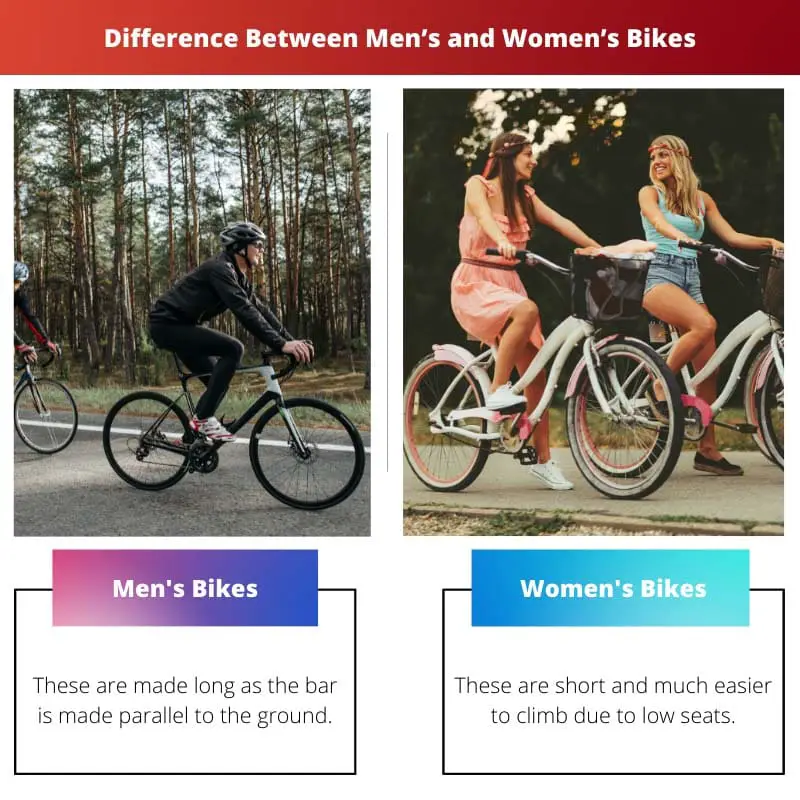Men’s and women’s bikes are made to incorporate practicality into bikes. Manufacturers develop frames for both bikes.
They have differences because men and women have changes in their body measurements, such as women have average, and narrower shoulders than men and women’s bikes have narrower bars than other bikes.
Key Takeaways
- Women’s bikes have a shorter top tube and longer seat tube for a better fit, while men’s bikes have a longer top tube.
- Handlebars on women’s bikes are narrower, and grips are smaller, providing better control for smaller hands.
- Women’s bikes may feature a step-through frame design, allowing for easier mounting and dismounting.
Men’s Bikes vs Women’s Bikes
Men’s bikes are bicycles that are fitted with thick, wide handlebars for men’s shoulders, long saddles, and a horizontal top tube to suit long arms. Women’s bikes are bikes that are made with a low-top tube, with thin and narrow handlebars, shorter saddle handlebars, and diverse colors.

Men’s bikes are general bikes built with a horizontal crossbar to empower the frame of the bike. These frames are made of carbon fibers to strengthen the bike’s structure.
As men are taller and broader than women, their bikes are designed to address these differences in body shapes to customize the fit.
On the other hand, women’s bikes are built based on dimensions that come from their shorter torso lengths (which makes the bikes have shorter reach heights) and shorter heights of women (to make the bike have shorter stack heights).
The classic women’s bikes have a downward-sloping top tube to design fit.
Comparison Table
| Parameter of Comparison | Men’s Bikes | Women’s Bikes |
|---|---|---|
| Frame structure | These are made long as the bar is made parallel to the ground. | These are short and much easier to climb due to low seats. |
| Seat shape | They have longer and narrower seats because men have narrow pelvic bones. | They have wide and shorter saddles to house the wider pelvic bones. |
| Handlebars | The stem of the handlebars is made wider than on women’s bikes. | The stem of the handlebars is shorter because women have smaller torsos. |
| Crank lengths | Men’s bikes have longer cranks due to longer torsos. | Due to shorter torsos, the cranks are made shorter. |
| Brakes, grips | Grips are made largely due to the long hands of men. Brake levers have a longer reach. | Grips are smaller and brake levers have a shorter reach to fit a woman’s smaller hands. |
What is Men’s Bike?
Men’s bikes are those bikes that are designed with a horizontal top tube having a long-saddle handlebar length to suit men’s long arms.
They have thicker, wide handlebars to comfort men’s broad shoulders and excellent grips. The saddles of the bikes are made long and slender with elegant designs and arrangements.
Men’s bikes are colored black because they are designed for men, and black becomes a classy color when it comes to men’s bikes.
Bikes are designed to suit every gender’s body shape and size. In this context, men’s bikes are made long and narrow, and the stems are built with carbon fiber to strengthen the frame structure of the bike.
Men’s bikes are made larger and have large body parts, making them fit for a man’s large stature. Men’s bikes are diverse from other bikes, both in size and structural build.
The difference is made in the length of the bike and the bike’s seating position.
For men’s bikes, there’s a large array of options available in the market, and each men’s bike manufacturer designs their bikes in such a way that they can fit and comfort almost every man so that the bike becomes worth it.

What is Women’s Bike?
When it comes to women’s bikes, the question of beauty and fit comes first so that the bike can suit every woman’s body with a customizable fit.
Women’s bikes are made with shorter saddle handlebars to comfort every woman’s shorter arms.
Contrary to men’s bikes, women’s bikes are made with a lowered top tube, and they have somewhat thinner, shorter, and narrower handlebars.
Women’s bikes feature wide and short saddles. The color choice of women’s bikes doesn’t come with women’s preference.
Unlike men, who can choose any color available for their bikes, women have a limited color choice. The most common color for women’s bikes is pink.
Then comes other colors. The differences between women’s and men’s bikes are not made to discriminate between the two genders but to agree upon the general preferences of men and women.
Additionally, the stems between handlebars on women’s bikes are not wider than the ones on men’s bikes.
It helps compensate for the shorter arms as women have a smaller torsos.
According to studies, men’s bikes are made suitable for tall women, while women’s bikes are ideal for shorter men. This is a matter of choice for women.

Main Differences Between Men’s Bikes and Women’s Bikes
- The seat tubes of men’s bikes are not at a steeper incline as they are made horizontal, whereas women’s bike seat tubes are at a steeper incline.
- The front wheels of men’s bikes are made less extruded, whereas women’s bikes have more extruded front wheels.
- Men’s bikes have horizontal top tubes, whereas women’s bikes have a lowered top tube.
- Men’s bikes have parallel crossbars to strengthen the frame, whereas women’s bikes have slanted crossbars to mount the bike efficiently.
- Men’s bikes are mannish and elegant and don’t have aesthetic designs, whereas women’s bikes are made with unparalleled aesthetic designs and look as the style is a one-of-a-kind feature of women’s bikes.

- https://journals.sagepub.com/doi/abs/10.3141/2125-03
- https://www.sciencedirect.com/science/article/pii/S0091743507003039

The clear articulation of the parameters of comparison and the main differences between men’s and women’s bikes facilitates a thorough comprehension of the specialized design approach.
Providing supporting references enriches the credibility of the article. The ergonomic analysis of the design differences provides a comprehensive understanding of the subject matter.
The intentional and functional design features for men’s and women’s bikes are explained with precision, providing an effective basis for distinguishing between the two categories.
The exploration of what constitutes men’s and women’s bikes is rigorous and well-researched, delving into various aspects of the distinct design criteria for each category.
The article offers an insightful and comprehensive overview of the differences between men’s and women’s bikes, outlining detailed dimensions and anatomical considerations.
This article elucidates the nuanced differences between men’s and women’s bikes, pointing out the anatomical and design distinctions that are tailored to each gender. It is a well-rounded perspective.
The article accurately dissects the structural and functional differences between men’s and women’s bikes, aiming to establish a beneficial understanding of the tailored design elements.
The article abounds in valuable information regarding the differences between men’s and women’s bikes. In particular, the comparison table is highly illustrative.